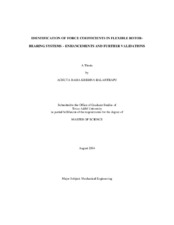| dc.description.abstract | Rotor-bearing system characteristics, such as natural frequencies, mode shapes, stiffness and damping coefficients, are essential to diagnose and correct vibration problems during system operation. Of the above characteristics, accurate identification of bearing force parameters, i.e. stiffness and damping coefficients, is one of the most difficult to achieve. Field identification by imbalance response measurements is a simple and often reliable way to determine synchronous speed force coefficients.
An enhanced method to estimate bearing support force coefficients in flexible rotor-bearing systems is detailed. The estimation is carried out from measurements obtained near bearing locations from two linearly independent imbalance tests. An earlier approach assumed rotordynamic measurements at the bearing locations, which is very difficult to realize in practice. The enhanced method relaxes this constraint and develops the procedure to estimate bearing coefficients from measurements near the bearing locations.
An application of the method is presented for a test rotor mounted on two-lobe hydrodynamic bearings. Imbalance response measurements for various imbalance magnitudes are obtained near bearing locations and also at rotor mid-span. At shaft speeds around the bending critical speed, the displacements at the rotor mid-span are an order of magnitude larger than the shaft displacements at the bearing locations. The enhanced identification procedure renders satisfactory force coefficients in the rotational speed range between 1,000 rpm and 4,000 rpm. The amount of imbalance mass needed to conduct the tests and to obtain reliable shaft displacement measurements influences slightly the magnitude of the identified force coefficients. The effect of increasing the number of rotor sub-elements in the finite-element modeling of the shaft is noted. Sensitivity of the method and derived parameters to noise in the measurements is also quantified. | en |


